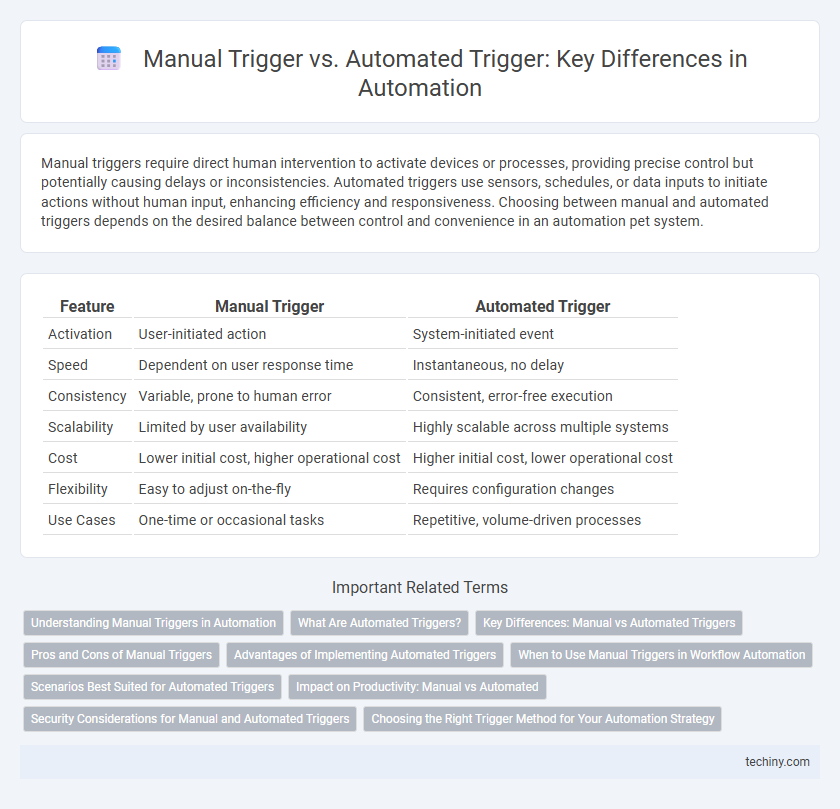Manual triggers require direct human intervention to activate devices or processes, providing precise control but potentially causing delays or inconsistencies. Automated triggers use sensors, schedules, or data inputs to initiate actions without human input, enhancing efficiency and responsiveness. Choosing between manual and automated triggers depends on the desired balance between control and convenience in an automation pet system.
Table of Comparison
| Feature | Manual Trigger | Automated Trigger |
|---|---|---|
| Activation | User-initiated action | System-initiated event |
| Speed | Dependent on user response time | Instantaneous, no delay |
| Consistency | Variable, prone to human error | Consistent, error-free execution |
| Scalability | Limited by user availability | Highly scalable across multiple systems |
| Cost | Lower initial cost, higher operational cost | Higher initial cost, lower operational cost |
| Flexibility | Easy to adjust on-the-fly | Requires configuration changes |
| Use Cases | One-time or occasional tasks | Repetitive, volume-driven processes |
Understanding Manual Triggers in Automation
Manual triggers in automation require direct human intervention to initiate a process, making them essential for tasks that demand precise control or confirmation. These triggers enable users to start workflows based on specific events or conditions that cannot be predefined or automated easily. Understanding manual triggers helps optimize automation systems by balancing human oversight with efficiency and reliability.
What Are Automated Triggers?
Automated triggers are predefined actions in automation systems that initiate workflows or processes based on specific events or conditions, such as receiving an email or reaching a set time. They enhance efficiency by eliminating the need for manual intervention, ensuring tasks are executed consistently and promptly. Examples include CRM systems activating follow-up emails when a lead reaches a scoring threshold or IoT devices adjusting settings based on sensor data.
Key Differences: Manual vs Automated Triggers
Manual triggers require direct human intervention to initiate processes, typically through buttons, commands, or user inputs, ensuring precise control and immediate response to specific tasks. Automated triggers operate based on predefined conditions or schedules, enabling workflows to run seamlessly without human involvement, increasing efficiency and reducing latency. Key differences include control level, execution speed, and dependency on user presence, with manual triggers emphasizing human oversight, while automated triggers prioritize consistency and scalability.
Pros and Cons of Manual Triggers
Manual triggers offer precise control over process initiation, allowing users to intervene and verify conditions before execution, which minimizes errors in sensitive tasks. However, they require constant human presence and can delay workflows, reducing overall efficiency compared to automated triggers. Reliance on manual triggers increases the risk of inconsistencies and operational bottlenecks in large-scale or time-critical automation systems.
Advantages of Implementing Automated Triggers
Automated triggers significantly enhance operational efficiency by eliminating the need for manual intervention, reducing human error, and enabling real-time response to specific events. They ensure consistent execution of processes such as email marketing campaigns, system alerts, and workflow approvals, which increases scalability and accuracy. Companies leveraging automated triggers experience higher productivity and improved customer engagement due to timely and personalized interactions.
When to Use Manual Triggers in Workflow Automation
Manual triggers in workflow automation are ideal for processes requiring human judgment or approval before initiation, such as quality checks or personalized customer interactions. They ensure precise control and reduce errors in sensitive tasks where automation may lack context awareness. Using manual triggers is crucial when workflows depend on specific timing or conditional decision-making that automation cannot accurately assess.
Scenarios Best Suited for Automated Triggers
Automated triggers excel in scenarios requiring real-time responses, such as e-commerce order processing, customer onboarding workflows, and system monitoring alerts. These triggers minimize human error, enhance efficiency, and enable seamless scalability across complex business processes. Enterprises leveraging automated triggers benefit from improved accuracy and consistent execution in repetitive, time-sensitive tasks.
Impact on Productivity: Manual vs Automated
Manual triggers often lead to delays and increased human error, reducing overall productivity by requiring continuous user intervention. Automated triggers accelerate workflows by instantly initiating tasks based on predefined conditions, minimizing downtime and freeing employees for higher-value activities. Integrating automated triggers can boost operational efficiency by up to 40%, significantly enhancing productivity in complex systems.
Security Considerations for Manual and Automated Triggers
Manual triggers require human intervention, increasing the risk of errors, unauthorized access, or delayed response to security incidents due to inconsistent application of security protocols. Automated triggers enhance security by ensuring timely and consistent execution of predefined actions, reducing human error and enabling real-time threat detection and response. However, automated triggers must be rigorously configured and monitored to prevent exploitation through false positives or malicious manipulation.
Choosing the Right Trigger Method for Your Automation Strategy
Choosing the right trigger method for your automation strategy hinges on balancing control and efficiency; manual triggers offer precise initiation by users, ideal for tasks requiring human judgment, while automated triggers enable seamless, real-time execution based on predefined conditions or events. Data-driven insights and workflow requirements should guide the decision, ensuring the trigger method aligns with operational goals and reduces latency. Integrating both manual and automated triggers can create a hybrid approach, enhancing flexibility and responsiveness in complex automation environments.
Manual Trigger vs Automated Trigger Infographic

 techiny.com
techiny.com